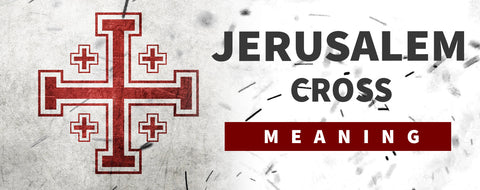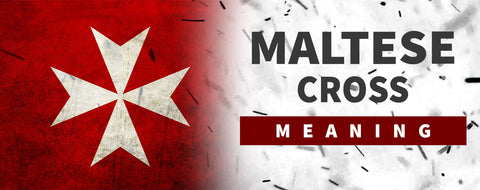
In Signo Hoc Vinces: Meaning and Origin
of reading - words
What does 'In Hoc Signo Vinces' mean ? Where does the expression 'In This Sign Thou Shalt Conquer' ? What does it mean ? How does it evoke the Christian cross ?
Welcome to Templar Cross, we will try to understand more deeply what the expression 'In Hoc Signo Vinces' really means.
Each expression has its own meaning. Whether it is a motto, a saying, or a proverb, honor is very present in the various symbols represented by religious Orders such as the Order of the Knights Templar.
In this article, you will discover :
- What does this Latin expression really mean ?
- 6 important points of this sentence
- The new philosophy of this expression
Let's go without further ado !
1) 'In Hoc Signo Vinces' : Meaning and Origin of this expression
'In Hoc Signo Vinces' means : "In This Sign Thou Shalt Conquer.” It is a famous Latin expression that dates back to the Roman Emperor Constantine : in 312, during the Battle of the Milvius Bridge, he is said to have had a vision : this expression mysteriously appeared to him in the sky accompanied by the Chrism (six-pointed cross). The sign of which this expression speaks is therefore the chrism, a form of Christian cross.
Let's dive into the details now...
A. 'In Hoc Signo Vinces' : The Battle of the Milvius Bridge
In 312, the Roman emperors Maxentius and Constantine are tearing each other apart for the control of the empire.
A few hours before the decisive battle of the Milvius Bridge (28 October 312), Constantine saw a cross in the sky, accompanied by the words 'In Hoc Signo Vinces' (which certainly appeared in Greek : ἐν τούτῳ νίκα) : "In This Sign Thou Shalt Conquer.”
Subjugated by this apparition "brighter than the sun,” Constantine had the cross reproduced on the standards and shields of his soldiers. He won the victory and entered Rome while his rival Maxentius drowned in the waters of the Tiber.
B. The importance of the expression 'In Hoc Signo Vinces'
The appearance of the expression 'In Hoc Signo Vinces' accompanied by the Chrism seems to ensure Constantine's victory. The triumph of the latter consecrates the beginning of a new era.
Indeed, this event turned Rome's religious destiny upside down : Constantine's revelation led him to draw closer to Christianity. And the entire Empire would follow. The Empire's entry into Christianity is a considerable event.

As a direct consequence, the repression against Christians ceased in 313 with the promulgation of the Edict of Milan, which proclaimed freedom of worship throughout the Empire.
In 325, Constantine brought together the bishops of East and West at a council in Nicaea. Christian unity is defined on the basis of a common dogma. The organization and discipline of the Church were codified.
C. The story of Eusebius of Caesarea
Eusebius of Caesarea (265-339), bishop of Caesarea in Palestine, close to Constantine, gives the following account in his work "The Life of Constantine" (First Book):
Chapter 28 : How God sent Constantine a vision while he was praying : a cross of light in the sky at noon and a writing that he would conquer by this sign.
Constantine implored the protection of this God, and asked him to make himself known to him and to assist him in the state in which his affairs were. While he was praying this prayer, he had a wonderful vision, which might seem incredible if it were reported by another. But no one must make it difficult to believe it, for this prince himself told me about it long ago, when I had the honor of entering into his good graces and the event confirmed the truth. He assured me that he had seen a luminous cross in the middle of noon with the inscription : "Conquer by this sign,” and that he was extremely astonished at this sight, as were his soldiers who followed him.

Chapter 29 : How the Christ of God appeared to him in a dream and commanded him to use the sign of the cross against his enemies.
This vision made such a strong impression on Constantine's mind that he was still occupied with it the next night. During his sleep, the Christ of God appeared to him with the same sign that he had shown him in the air during the day, and commanded him to make a banner of the same shape and to carry it in battle to guard himself from danger.
Chapter 30 : Making the Sign of the Cross.
Constantine, having risen at the crack of dawn, told his friends the dream he had had, and having sent for goldsmiths and lapidaries, he sat down among them, described to them the figure of the sign he had seen, and commanded them to make a similar one, enriched with gold and stones.
Chapter 31 : Description of the sign in the form of a cross, which the Romans now call labarum. See our article on chrism.
Chapter 32 : How Constantine, once catechized, read the Holy Scriptures.
D. The story of Lactantius
Lactantius (about 250-325), a writer close to Constantine, gives the following account in his work "Of the death of the persecutors (Chapter XLIV, 4-10) :
(...) Constantine, determined to see what might happen, approached Rome, and camped at the bridge of Milvius. It was the twenty-seventh day of October, the day on which Maxentius had taken the purple, and on which the Quinquennales ended. Constantine, warned in a dream to have the adorable sign of the cross painted on the shields of his soldiers, and then to engage in battle, obeyed, and had an X, with a circumflex accent meaning Jesus Christ, painted on his shields. His troops fortified with this heavenly armor prepared themselves for battle. The enemy army, in the absence of his emperor, crossed the bridge. They shocked each other with equal vigor on both sides. However, the people of Rome are moved and reproach Maxentius for betraying the public cause. Frightened by this murmur, he called a few senators and consulted the book of the sibyls, where it is found that on that same day the enemy of the Roman people was to perish. He interpreted the oracle to his advantage and, certain of victory, he ran to battle. He breaks the bridge after him, so that the necessity of victory gives more courage to his army; after which the battle heats up. But God favored Constantine : his enemies were afraid. Maxentius wants to save himself; the broken bridge is an obstacle to his escape. Carried away by the multitude of fugitives, he is thrown into the Tiber. After such an important victory, Constantine was received in Rome with the applause of the senate and the people. (…)
Lactantius does not speak of the expression 'In Hoc Signo Vinces,' but only of Chrism, which appeared not in heaven at midday, but in a 'dream.’ The version of Lactantius is therefore slightly different from Eusebius' version of Caesarea.
E. The Chrism
The expression 'In Hoc Signo Vinces' is inseparable from Chrism, so much so that it is sometimes translated as : "by the cross of conquest."

The chrism is a Christian symbol composed of the Greek letters Χ and Ρ corresponding to the first two letters of the Greek word Χριστός, that is Khristós : Christ. It is sometimes completed with the alpha and omega letters symbolizing the beginning and the end.
The chrism is also the labarum : military standard struck with the cross, adopted by Constantine's army.
F. A little hindsight on Constantine's vision
We do not know whether the legend of Constantine's vision is real or whether it is part of a propaganda operation aimed at gradually imposing Christianity throughout the Roman Empire.
In any case, it is the first time that the cross was adopted as a sign of recognition and rallying by a Roman emperor (in place of the eagle in particular).
The cross became a major symbol, a symbol of military victory, in the same way that fragments of the True Cross would later be carried to meet the enemy on the battlefield.

Today, the meaning of the expression 'In Hoc Signo Vinces' has evolved: "In This Sign Thou Shalt Conquer," can remind believers that they must work tirelessly to overcome their evil inclinations and to strike down evil, guided by the cross.
Note : In the novel Esther Jones and the 7 Secrets of the Cross, the Chrism and the expression 'In Hoc Signo Vinces' are keys to solving the enigma of the location of the relics of the True Cross.
2) 'In Hoc Signo Vinces' : The New Philosophy
For thirty years, the new philosophy has raised the flag of harmony and peace above the old schools. 'In Hoc Signo Vinces' ! But it is not enough to speak of an alliance, the conditions must be clearly set out.
- Vacherot :
To organize, to apply effectively in France the principles of '89, which have so far lived only a theoretical and abstract life, to embrace valiantly the cause of popular progress, to bring the light of education down to the ranks of the underprivileged of the social order, this is the obvious task of our century, the career open to the activity of superior men, to the ambition of families who want to reign : 'In Hoc Signo Vinces'.
- Ad. Guéroult :
Fernand Cortez showed his soldiers a wooden statuette of the Virgin, and told them it had been sent to him from Heaven as a testimony of grace, as a promise of salvation : 'In Hoc Signo Vinces'. And the pious soldiers, revived by a holy belief, returned to battle and defeated Guatimozin's army.
- X. Marmier :
By placing the ideal in the future, instead of chaining it to the past, modern philosophy has deserved to serve as a stem for this tree of the future which it has, so to speak, planted with its own hands, and it must obtain from our respects that we keep its formula, and that more and more we hold high its banner : 'In Hoc Signo Vinces'.
Hoping you liked our blog post, here is a set of In Hoc Signo Vinces T-Shirts :







Steve marshall
I have a bolo tie with medal with cross and in hoc words symbol Christian conqueror
Anna
Found at a thrift store, a stein with this sign under a cross with blue background, above that is an head of an eagle with a key in it’s mouth. Also 1970, university of Oklahoma on it.
Charles
I have a old watch fob with this trade and a cross on it .
Cameron jackson
in my field finding this saying actually belongs to the The DOMA Daughters of Ma’at